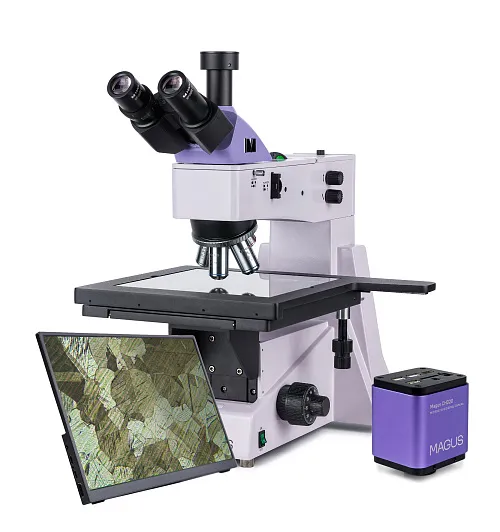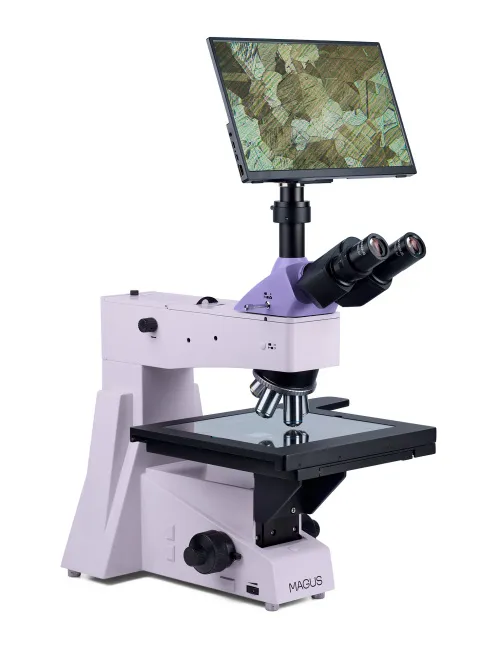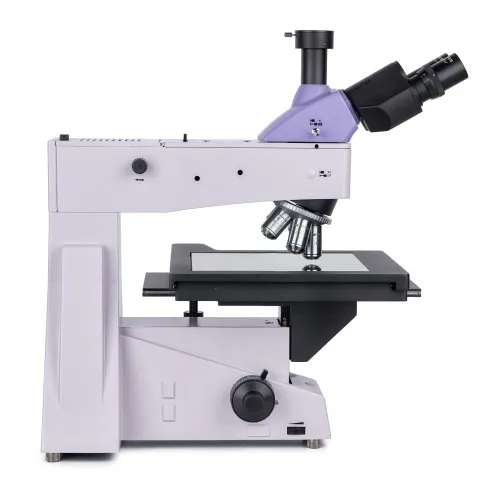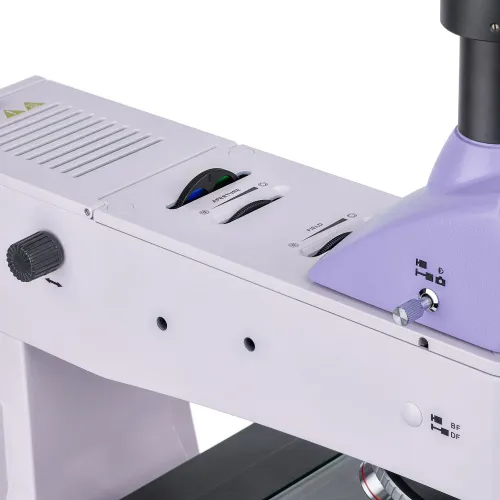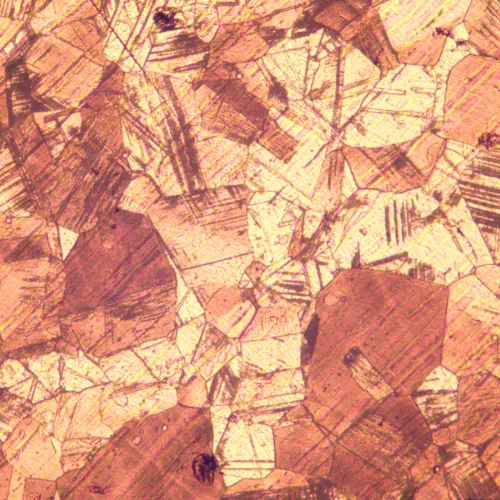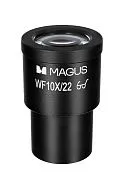MAGUS Metal D650 LCD Metallurgical Digital Microscope
With a camera and monitor. Magnification: 50–800х. Trinocular head, plan achromatic objectives, 30W halogen reflected light illuminator, fine focusing scale value 0.7µm, large stage
| Product ID | 83033 |
| Brand | MAGUS |
| Warranty | 5 years |
| EAN | 5905555018409 |
| Package size (LxWxH) | 58x49x60 cm |
| Shipping Weight | 23.75 kg |
The MAGUS Metal D650 LCD Metallurgical Microscope has a large stage where you can place photomasks, printed circuit boards, integrated circuits, and other long and wide specimens to be examined in reflected light. Brightfield and polarized light observations are possible. The microscope provides high precision focusing. The fine focusing scale value of 0.7µm makes it easy to work at high magnifications. It is used for conducting research in industrial plants and teaching engineering students.
Digital camera
The MAGUS CHD20 Digital Camera is equipped with a 2MP sensor and produces realistic Full HD images at a resolution of 1920x1080px. The camera features high light sensitivity that is suitable for working in fluorescent light. Through the use of R, G, B primary color mosaic filters, low dark current and clear image are achieved. The camera uses an HDMI interface to connect directly to a TV, monitor, or projector. In this mode, the camera operates autonomously without a PC. The HDMI interface provides a high and stable transfer rate from the camera to the external screen. An additional USB2.0 interface is provided for connecting the camera to a PC. Video is recorded at 60fps or 50fps depending on the video output interface. The camera combines high FPS and high bandwidth HDMI and, therefore, videos are vivid with no freezes or gaps between frames. At maximum resolution, the image is well-detailed, moving objects are visible without bugs, and object movement is displayed without delays.
Monitor
MAGUS MCD monitors work in combination with MAGUS CHD cameras to form a complete imaging system for MAGUS microscopes.
The connection to the camera occurs via its HDMI interface. The monitor displays real-time images. Its IPS LCD display has a wide viewing angle, high brightness, and good contrast. When looking at the screen even from a large angle, the image is not distorted. The screen size is 13.3''.
The monitor can be installed on a horizontal surface using a folding stand or mounted directly on a camera or tripod.
Optics
Infinity plan achromatic optics deliver sharp well-detailed images. The microscope head is trinocular, 30° inclined, and a trinocular tube for mounting a digital camera. The camera (not included) captures the photos and videos of the study and outputs the microscope image to an external screen. There is a two-position-beamsplitter: 100:0 and 0:100. The light beam is directed into the eyepieces or to the camera. There is a diopter adjustment ring on the left tube.
You can install 5 objectives in the revolving nosepiece – all of them are included in the package. To achieve higher magnification, you can install optional objectives instead of the basic ones. In the basic configuration, the microscope provides magnification in a range of 50 to 800x. The revolving nosepiece with objectives is oriented toward the interior – the user can see the objective inserted into the optical path.
Illumination
The reflected light illumination system combines three centering elements: light source, aperture, and field diaphragm. The 30W halogen illuminator emits warm light, and so working with the microscope for long periods of time does not make your eyes fatigue. The brightness of the illumination is adjustable, it is possible to set the Köhler illumination. The reflected light illumination system also comes with a polarization device: a built-in analyzer and a detachable rotating polarizer. There is a set of color filters.
Stage and focusing mechanism
The most interesting part of the microscope design is the 280x270 mm stage, which can be moved along two axes within 204mm. Therefore, you can observe large-sized samples and examine their surface easily. The coarse and fine focusing knobs are coaxial located on both sides of the microscope, with a lock knob and coarse tension adjustment knob. The handles are located close to the microscope base, you can place your hands freely on the table and take a comfortable position while observing.
Accessories
The MAGUS Metal D650 LCD line of microscope-compatible accessories includes eyepieces, long working distance objectives, digital cameras, and calibration slides. The accessories can be used to expand the capabilities of the microscope.
Key features of the microscope:
- Large stage with a wide movement range for working with long and wide samples
- Fine focusing scale value 0.7µm for easy focusing at high magnifications; coarse focusing with a lock knob and tension adjustment
- Trinocular head with a trinocular tube and a beam splitter
- Reflected light illuminator: powerful 30W halogen bulb with brightness adjustment, and powered by AC power supply
- Polarization device, elements of the reflected light illuminator that can be centered, Köhler illumination, color filters
- Wide range of compatible optional accessories
Key features of the camera:
- The camera operates autonomously without a connection to a PC via HDMI interface. Can be connected to a PC via USB2.0 interface
- The camera resolution is 1920x1080px – an ideal choice for displaying images on a Full HD monitor
- 60fps or 50fps depending on the video output interface for observing moving objects, recording video, and moving the preparation without jerkiness or lags
- SONY Starvis color CMOS backlit sensor provides low noise level and high light sensitivity even in low-light conditions. You will get clearer, brighter, and more color-saturated images.
- Software with photo, video recording, editing, external display functions, linear and angular measurements
The kit includes:
- MAGUS CHD20 Digital Camera (digital camera, HDMI cable (1.5m), USB 2.0 cable (2m), USB mouse, 32GB SD memory card, AC power adapter 12V/1A (Euro), installation CD with drivers and software, user manual and warranty card)
- MAGUS MCD20 LCD Monitor
- Base with a power input, reflected light source, focusing mechanism, stage, and revolving nosepiece
- Trinocular head
- Infinity plan achromatic objective: PL L5x/0.12 WD 26.1mm
- Infinity plan achromatic objective: PL L10х/0.25 WD 20.2mm
- Infinity plan achromatic objective: PL L20х/0.40 WD 8.80mm
- Infinity plan achromatic objective: PL L50х/0.70 WD 3.68mm
- Infinity plan achromatic objective: PL L80x/0.80 WD 1.25mm
- Eyepiece 10x/22mm with long eye relief (2 pcs.)
- C-mount adapter 1x
- Hex key wrench
- AC power cord
- Dust cover
- User manual and warranty card
Available on request:
- 10x/22mm eyepiece with a scale
- 12.5x/14mm eyepiece (2 pcs.)
- 15x/15mm eyepiece (2 pcs.)
- 20x/12mm eyepiece (2 pcs.)
- 25x/9mm eyepiece (2 pcs.)
- Infinity plan achromatic objective: PL L40х/0.60 WD 3.98mm
- Infinity plan achromatic objective: PL L60x/0.70 WD 2.08mm
- Infinity plan achromatic objective: PL L100x/0.85 (dry) WD 0.40mm
- Calibration slide
| Product ID | 83033 |
| Brand | MAGUS |
| Warranty | 5 years |
| EAN | 5905555018409 |
| Package size (LxWxH) | 58x49x60 cm |
| Shipping Weight | 23.75 kg |
| Type | light/optical, digital, metallurgical |
| Microscope head type | trinocular, digital screen/PC monitor |
| Head | Siedentopf |
| Head inclination angle | 30 ° |
| Magnification, x | 50 — 800 |
| Magnification, x (optional) | 50–1000/1250/1500/2000/2500 |
| Eyepiece tube diameter, mm | 30 |
| Eyepieces | 10х/22mm, eye relief: 10mm (*optional: 10x/22mm with scale, 12.5x/14; 15x/15; 20x/12; 25x/9) |
| Objectives | infinity plan achromatic: PL L5x/0.12, PL L10x/0.25, PL L20x/0.40, PL L50x/0.70, PL L80x/0.80; parfocal distance 45mm (*option: PL L40x/0.60, PL L60x/0.70, PL L100x/0.85 (dry)) |
| Revolving nosepiece | for 5 objectives |
| Working distance, mm | 26.1 (5x); 20.2 (10x); 3.98 (40x); 2.08 (60x); 8.80 (20x); 3.68 (50x); 1.25 (80x); 0.40 (100x) |
| Interpupillary distance, mm | 48 — 75 |
| Stage, mm | 280x270 |
| Stage moving range, mm | 204/204 |
| Stage features | two-axis mechanical |
| Eyepiece diopter adjustment, diopters | ±5 (on the left tube) |
| Diaphragm | built-in aperture and field |
| Focus | coaxial, coarse focusing (30mm, 13.1mm/circle, with a lock knob and tension adjusting knob) and fine focusing (0.0007mm) |
| Illumination | halogen |
| Brightness adjustment | ✓ |
| Power supply | 220±22V, 50Hz, AC network |
| Light source type | 12V/30W |
| Light filters | green, blue, yellow, matt |
| Operating temperature range, °C | 5...+35 |
| Additional | built-in analyzer and removable polarizer |
| User level | experienced users, professionals |
| Assembly and installation difficulty level | complicated |
| Application | metallurgical |
| Illumination location | upper |
| Research method | bright field, polarization |
| Pouch/case/bag in set | dust cover |
| Camera specifications | |
| Sensor | Sony Exmor/Starvis CMOS |
| Color/monochrome | color |
| Megapixels | 2 |
| Maximum resolution, pix | 1920x1080 |
| Sensor size | 1/2" (7.2x4.05mm) |
| Pixel size, μm | 3.75x3.75 |
| Interface connectors | HDMI 1.4, USB 2.0 |
| Memory card | SD up to 32GB |
| Ability to connect additional equipment | USB mouse, flash stick (USB) |
| Light sensitivity | 1175mV with 1/30s |
| Signal/noise ratio | 0.15mV at 1/30s |
| Exposure time | 0.04ms–1000ms |
| Video recording | ✓ |
| Frame rate, fps at resolution | 50@1920x1080 (USB), 60@1920x1080 (HDMI) |
| Place of installation | trinocular tube, eyepiece tube instead of an eyepiece |
| Image format | *.jpg, *.tif |
| Video format | *.h264/*.h265, *.mp4 |
| Spectral range, nm | 380–650 (built-in IR filter) |
| Shutter type | ERS (electronic rolling shutter) |
| Software | HDMI: built-in; USB: MAGUS View |
| System requirements | Windows 8/10/11 (32bit and 64bit), Mac OS X, Linux, up to 2.8GHz Intel Core 2 or higher, minimum 4GB RAM, USB2.0 port, RJ45, 19" or larger display |
| Mount type | C-mount |
| Body | CNC aluminum alloy |
| Camera power supply | DC adapter 12V, 1A |
| Camera operating temperature range, °С | -10...+50 |
| Operating humidity range, % | 30 — 80 |
| Monitor specifications | |
| Type of matrix | IPS |
| Display diagonal, inch | 13.3 |
| Display resolution, px | 1920x1080 (Full HD) |
| Aspect ratio | 16:9 |
| Brightness, cd/m² | 400 |
| Number of displayed colors | 16.7 m |
| Contrast | 1000:1 |
| Horizontal/vertical viewing angle, ° | 178/178 |
| Size of the visible screen area (WxH), mm | 295x165 |
| Pixel pitch (WxH), mm | 0.154x0.154 |
| Frequency of optical source, Hz | 60 |
| Type of matrix backlight | LED |
| LED backlight lifetime, h | 50000 |
| Interface | HDMI |
| Operating temperature range, °C | -15...+55 |
| Operating humidity range, % | 10 — 90 |
| Power supply | AC 110–220V, DC 5–12V/1A (Type-C) |
| Power consumption, W | 12 (max.) |
and downloads
We have gathered answers to the most frequently asked questions to help you sort things out
Find out why studying eyes under a microscope is entertaining; how insects’ and arachnids’ eyes differ and what the best way is to observe such an interesting specimen
Read this review to learn how to observe human hair, what different hair looks like under a microscope and what magnification is required for observations
Learn what a numerical aperture is and how to choose a suitable objective lens for your microscope here
Learn what a spider looks like under microscope, when the best time is to take photos of it, how to study it properly at magnification and more interesting facts about observing insects and arachnids
This review for beginner explorers of the micro world introduces you to the optical, illuminating and mechanical parts of a microscope and their functions
Short article about Paramecium caudatum - a microorganism that is interesting to observe through any microscope

